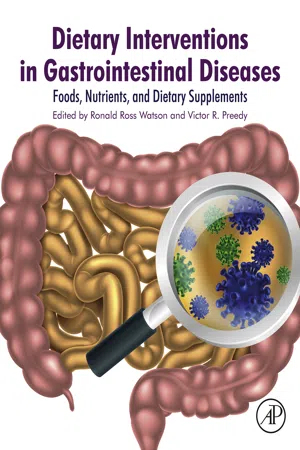
Dietary Interventions in Gastrointestinal Diseases
Foods, Nutrients, and Dietary Supplements
- 358 pages
- English
- ePUB (mobile friendly)
- Available on iOS & Android
Dietary Interventions in Gastrointestinal Diseases
Foods, Nutrients, and Dietary Supplements
About This Book
Dietary Interventions in Gastrointestinal Diseases: Foods, Nutrients and Dietary Supplements provides valuable insights into the agents that affect metabolism and other health-related conditions in the gastrointestinal system. It provides nutritional treatment options for those suffering from gastrointestinal diseases including Crohn's Disease, Inflammatory Bowel Disease, Ulcerative Colitis and Allergies, among others. Information is presented on a variety of foods, including herbs, fruits, soy and olive oil, thus showing that changes in intake can change antioxidant and disease preventing non-nutrients and affect gastrointestinal health and/or disease promotion.
This book serves as a valuable resource for biomedical researchers who focus on identifying the causes of gastrointestinal diseases and food scientists targeting health-related product development.
- Provides information on agents that affect metabolism and other health-related conditions in the gastrointestinal tract
- Explores the impact of composition, including differences based on country of origin and processing techniques to highlight compositional differences and their effect on the gastrointestinal tract
- Addresses the most positive results from dietary interventions using bioactive foods to impact gastrointestinal diseases, including reduction of inflammation and improved function of organs
Frequently asked questions
Information
Plant Family, Carvacrol, and Putative Protection in Gastric Cancer
Abstract
Keywords
1. Plant Family and Phytochemicals
1.1. General Properties of Dietary Phytochemicals
1.2. Classification of Phytochemicals
1.3. Mechanisms of Phytochemicals in Cancer Chemoprevention
Table of contents
- Cover image
- Title page
- Table of Contents
- Copyright
- List of Contributors
- Biography
- Acknowledgments
- Section I. Background and Overview of Diet and GI Tract Health
- Section II. Nutrition and GI Tract
- Section III. Probiotics, Prebiotics, Symbiotics in Intestinal Functions
- Section IV. Microbes and GI Tract
- Section V. Foods and Macro Dietary Materials in GI Function
- Index